2007 ISUZU KB P190 service
[x] Cancel search: servicePage 3478 of 6020
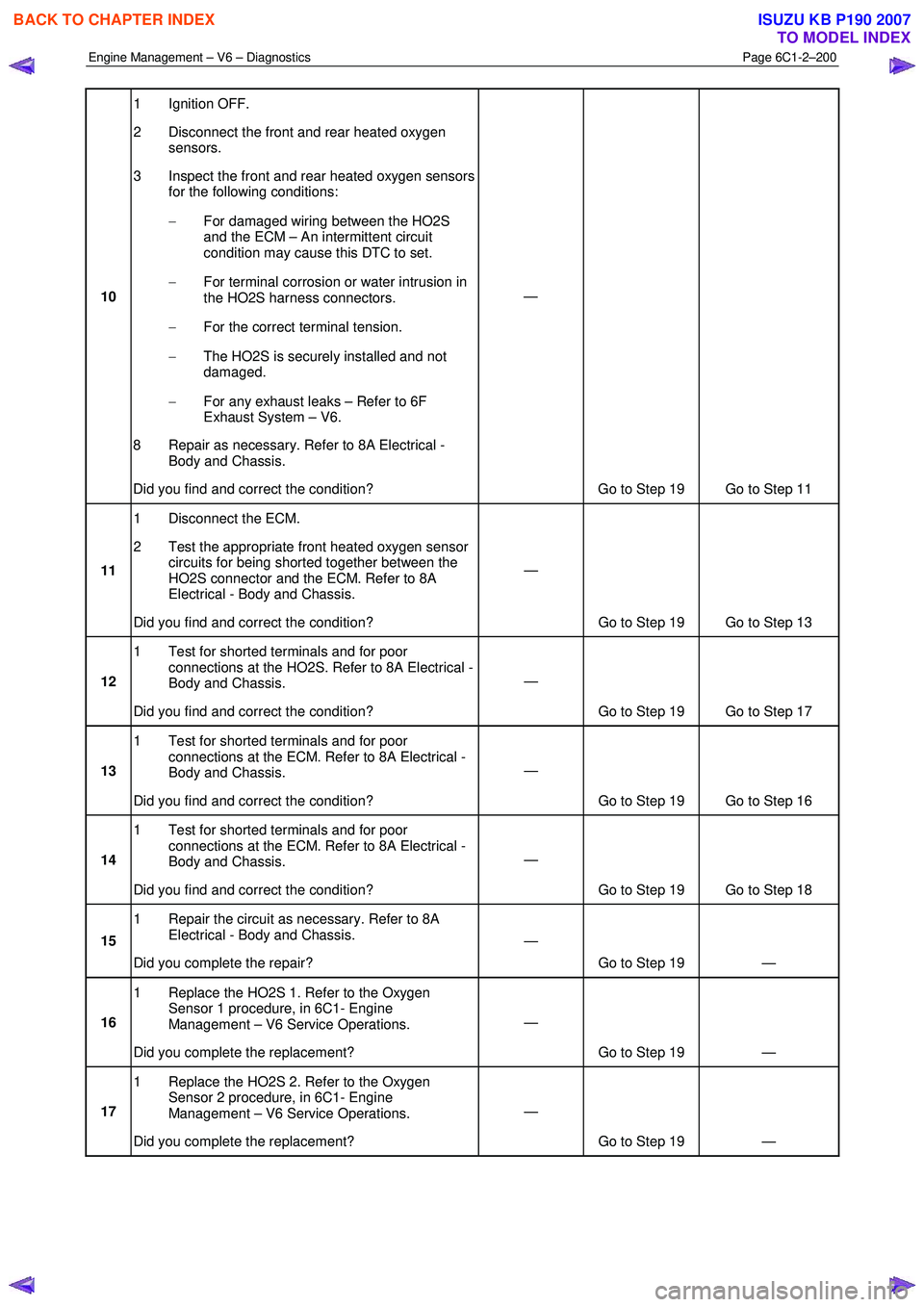
Engine Management – V6 – Diagnostics Page 6C1-2–200
10 1 Ignition OFF.
2 Disconnect the front and rear heated oxygen sensors.
3 Inspect the front and rear heated oxygen sensors for the following conditions:
− For damaged wiring between the HO2S
and the ECM – An intermittent circuit
condition may cause this DTC to set.
− For terminal corrosion or water intrusion in
the HO2S harness connectors.
− For the correct terminal tension.
− The HO2S is securely installed and not
damaged.
− For any exhaust leaks – Refer to 6F
Exhaust System – V6.
8 Repair as necessary. Refer to 8A Electrical - Body and Chassis.
Did you find and correct the condition? —
Go to Step 19 Go to Step 11
11 1 Disconnect the ECM.
2 Test the appropriate front heated oxygen sensor circuits for being shorted together between the
HO2S connector and the ECM. Refer to 8A
Electrical - Body and Chassis.
Did you find and correct the condition? —
Go to Step 19 Go to Step 13
12 1 Test for shorted terminals and for poor
connections at the HO2S. Refer to 8A Electrical -
Body and Chassis.
Did you find and correct the condition? —
Go to Step 19 Go to Step 17
13 1 Test for shorted terminals and for poor
connections at the ECM. Refer to 8A Electrical -
Body and Chassis.
Did you find and correct the condition? —
Go to Step 19 Go to Step 16
14 1 Test for shorted terminals and for poor
connections at the ECM. Refer to 8A Electrical -
Body and Chassis.
Did you find and correct the condition? —
Go to Step 19 Go to Step 18
15 1 Repair the circuit as necessary. Refer to 8A
Electrical - Body and Chassis.
Did you complete the repair? —
Go to Step 19 —
16 1 Replace the HO2S 1. Refer to the Oxygen
Sensor 1 procedure, in 6C1- Engine
Management – V6 Service Operations.
Did you complete the replacement? —
Go to Step 19 —
17 1 Replace the HO2S 2. Refer to the Oxygen
Sensor 2 procedure, in 6C1- Engine
Management – V6 Service Operations.
Did you complete the replacement? —
Go to Step 19 —
BACK TO CHAPTER INDEX
TO MODEL INDEX
ISUZU KB P190 2007
Page 3479 of 6020
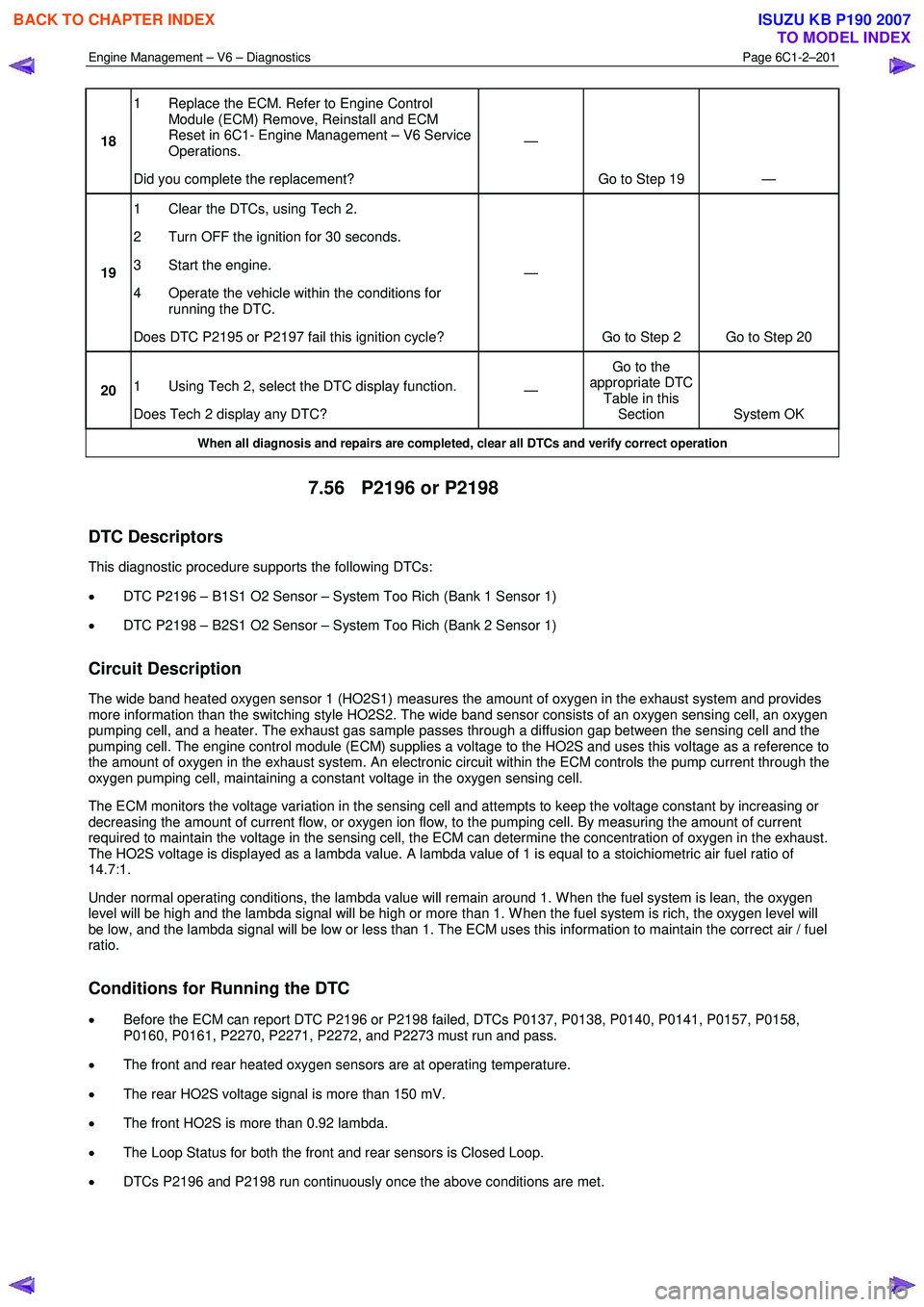
Engine Management – V6 – Diagnostics Page 6C1-2–201
18 1 Replace the ECM. Refer to Engine Control
Module (ECM) Remove, Reinstall and ECM
Reset in 6C1- Engine Management – V6 Service
Operations.
Did you complete the replacement? —
Go to Step 19 —
19 1 Clear the DTCs, using Tech 2.
2 Turn OFF the ignition for 30 seconds.
3 Start the engine.
4 Operate the vehicle within the conditions for running the DTC.
Does DTC P2195 or P2197 fail this ignition cycle? —
Go to Step 2 Go to Step 20
20 1 Using Tech 2, select the DTC display function.
Does Tech 2 display any DTC? —
Go to the
appropriate DTC Table in this Section System OK
When all diagnosis and repairs are completed, clear all DTCs and verify correct operation
7.56 P2196 or P2198
DTC Descriptors
This diagnostic procedure supports the following DTCs:
• DTC P2196 – B1S1 O2 Sensor – System Too Rich (Bank 1 Sensor 1)
• DTC P2198 – B2S1 O2 Sensor – System Too Rich (Bank 2 Sensor 1)
Circuit Description
The wide band heated oxygen sensor 1 (HO2S1) measures the amount of oxygen in the exhaust system and provides
more information than the switching style HO2S2. The wide band sensor consists of an oxygen sensing cell, an oxygen
pumping cell, and a heater. The exhaust gas sample passes through a diffusion gap between the sensing cell and the
pumping cell. The engine control module (ECM) supplies a voltage to the HO2S and uses this voltage as a reference to
the amount of oxygen in the exhaust system. An electronic circuit within the ECM controls the pump current through the
oxygen pumping cell, maintaining a constant voltage in the oxygen sensing cell.
The ECM monitors the voltage variation in the sensing cell and attempts to keep the voltage constant by increasing or
decreasing the amount of current flow, or oxygen ion flow, to the pumping cell. By measuring the amount of current
required to maintain the voltage in the sensing cell, the ECM can determine the concentration of oxygen in the exhaust.
The HO2S voltage is displayed as a lambda value. A lambda value of 1 is equal to a stoichiometric air fuel ratio of
14.7:1.
Under normal operating conditions, the lambda value will remain around 1. W hen the fuel system is lean, the oxygen
level will be high and the lambda signal will be high or more than 1. W hen the fuel system is rich, the oxygen level will
be low, and the lambda signal will be low or less than 1. The ECM uses this information to maintain the correct air / fuel
ratio.
Conditions for Running the DTC
• Before the ECM can report DTC P2196 or P2198 failed, DTCs P0137, P0138, P0140, P0141, P0157, P0158,
P0160, P0161, P2270, P2271, P2272, and P2273 must run and pass.
• The front and rear heated oxygen sensors are at operating temperature.
• The rear HO2S voltage signal is more than 150 mV.
• The front HO2S is more than 0.92 lambda.
• The Loop Status for both the front and rear sensors is Closed Loop.
• DTCs P2196 and P2198 run continuously once the above conditions are met.
BACK TO CHAPTER INDEX
TO MODEL INDEX
ISUZU KB P190 2007
Page 3482 of 6020
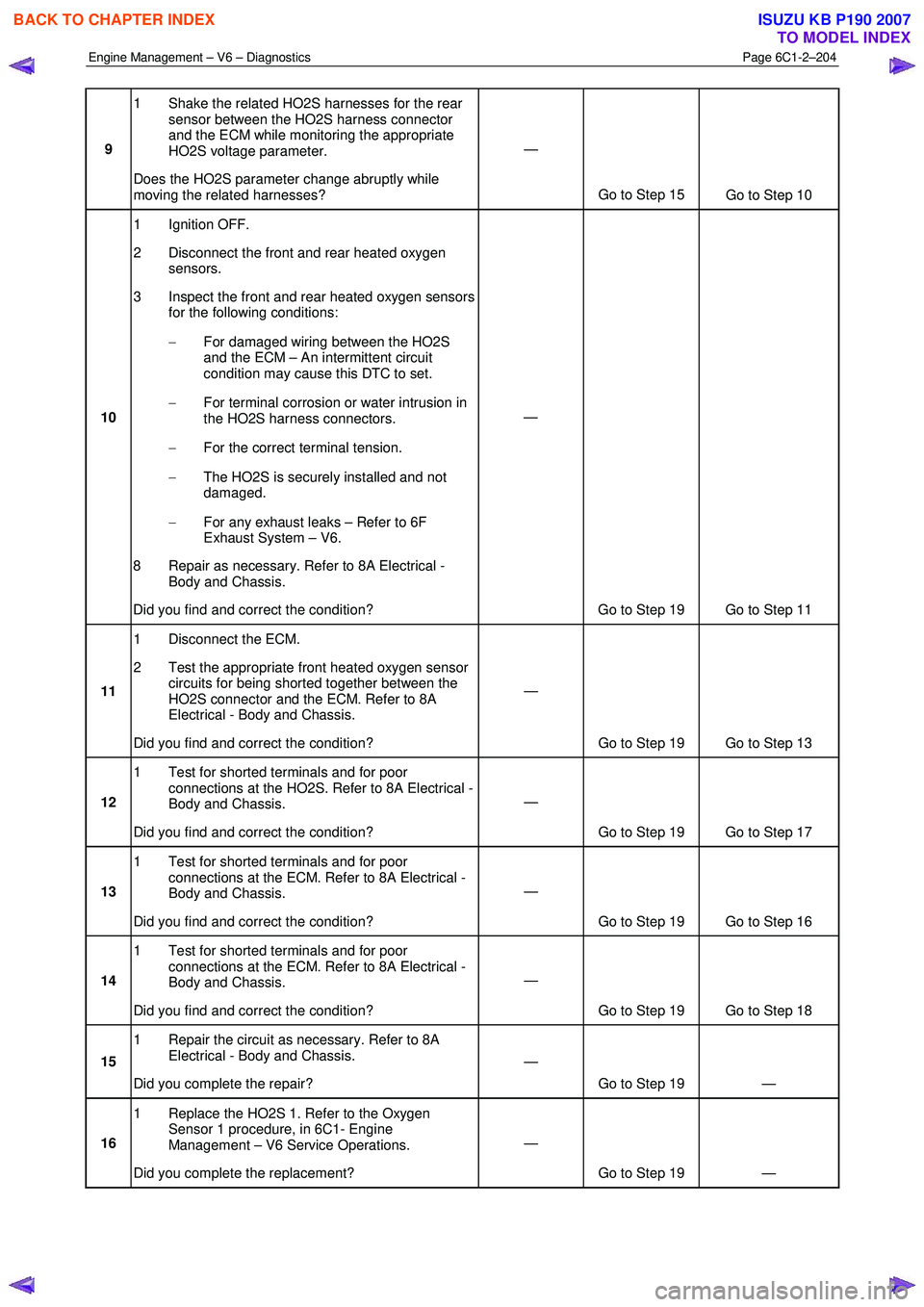
Engine Management – V6 – Diagnostics Page 6C1-2–204
9 1 Shake the related HO2S harnesses for the rear
sensor between the HO2S harness connector
and the ECM while monitoring the appropriate
HO2S voltage parameter.
Does the HO2S parameter change abruptly while
moving the related harnesses? —
Go to Step 15 Go to Step 10
10 1 Ignition OFF.
2 Disconnect the front and rear heated oxygen sensors.
3 Inspect the front and rear heated oxygen sensors for the following conditions:
− For damaged wiring between the HO2S
and the ECM – An intermittent circuit
condition may cause this DTC to set.
− For terminal corrosion or water intrusion in
the HO2S harness connectors.
− For the correct terminal tension.
− The HO2S is securely installed and not
damaged.
− For any exhaust leaks – Refer to 6F
Exhaust System – V6.
8 Repair as necessary. Refer to 8A Electrical - Body and Chassis.
Did you find and correct the condition? —
Go to Step 19 Go to Step 11
11 1 Disconnect the ECM.
2 Test the appropriate front heated oxygen sensor circuits for being shorted together between the
HO2S connector and the ECM. Refer to 8A
Electrical - Body and Chassis.
Did you find and correct the condition? —
Go to Step 19 Go to Step 13
12 1 Test for shorted terminals and for poor
connections at the HO2S. Refer to 8A Electrical -
Body and Chassis.
Did you find and correct the condition? —
Go to Step 19 Go to Step 17
13 1 Test for shorted terminals and for poor
connections at the ECM. Refer to 8A Electrical -
Body and Chassis.
Did you find and correct the condition? —
Go to Step 19 Go to Step 16
14 1 Test for shorted terminals and for poor
connections at the ECM. Refer to 8A Electrical -
Body and Chassis.
Did you find and correct the condition? —
Go to Step 19 Go to Step 18
15 1 Repair the circuit as necessary. Refer to 8A
Electrical - Body and Chassis.
Did you complete the repair? —
Go to Step 19 —
16 1 Replace the HO2S 1. Refer to the Oxygen
Sensor 1 procedure, in 6C1- Engine
Management – V6 Service Operations.
Did you complete the replacement? —
Go to Step 19 —
BACK TO CHAPTER INDEX
TO MODEL INDEX
ISUZU KB P190 2007
Page 3483 of 6020
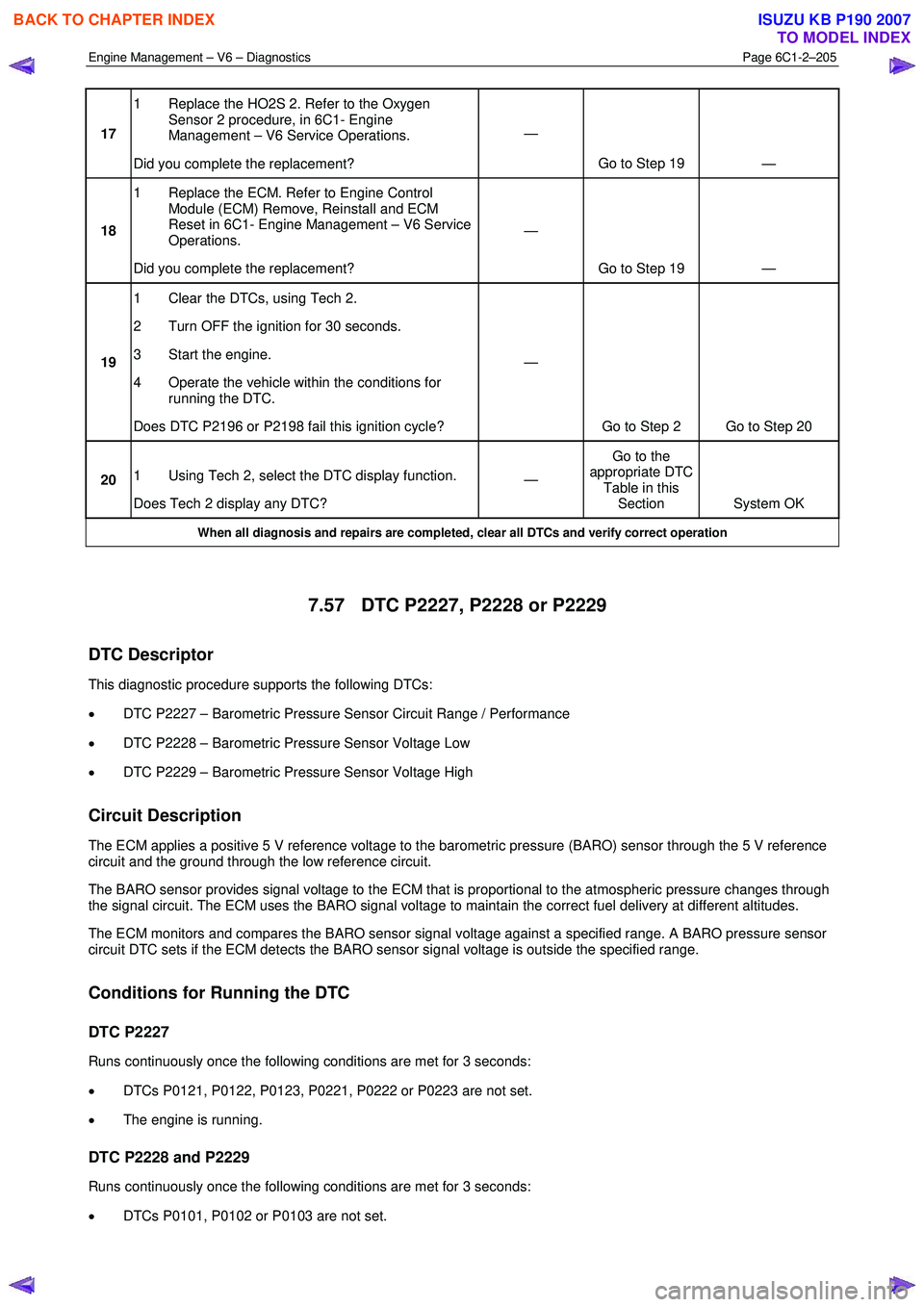
Engine Management – V6 – Diagnostics Page 6C1-2–205
17 1 Replace the HO2S 2. Refer to the Oxygen
Sensor 2 procedure, in 6C1- Engine
Management – V6 Service Operations.
Did you complete the replacement? —
Go to Step 19 —
18 1 Replace the ECM. Refer to Engine Control
Module (ECM) Remove, Reinstall and ECM
Reset in 6C1- Engine Management – V6 Service
Operations.
Did you complete the replacement? —
Go to Step 19 —
19 1 Clear the DTCs, using Tech 2.
2 Turn OFF the ignition for 30 seconds.
3 Start the engine.
4 Operate the vehicle within the conditions for running the DTC.
Does DTC P2196 or P2198 fail this ignition cycle? —
Go to Step 2 Go to Step 20
20 1 Using Tech 2, select the DTC display function.
Does Tech 2 display any DTC? —
Go to the
appropriate DTC Table in this Section System OK
When all diagnosis and repairs are completed, clear all DTCs and verify correct operation
7.57 DTC P2227, P2228 or P2229
DTC Descriptor
This diagnostic procedure supports the following DTCs:
• DTC P2227 – Barometric Pressure Sensor Circuit Range / Performance
• DTC P2228 – Barometric Pressure Sensor Voltage Low
• DTC P2229 – Barometric Pressure Sensor Voltage High
Circuit Description
The ECM applies a positive 5 V reference voltage to the barometric pressure (BARO) sensor through the 5 V reference
circuit and the ground through the low reference circuit.
The BARO sensor provides signal voltage to the ECM that is proportional to the atmospheric pressure changes through
the signal circuit. The ECM uses the BARO signal voltage to maintain the correct fuel delivery at different altitudes.
The ECM monitors and compares the BARO sensor signal voltage against a specified range. A BARO pressure sensor
circuit DTC sets if the ECM detects the BARO sensor signal voltage is outside the specified range.
Conditions for Running the DTC
DTC P2227
Runs continuously once the following conditions are met for 3 seconds:
• DTCs P0121, P0122, P0123, P0221, P0222 or P0223 are not set.
• The engine is running.
DTC P2228 and P2229
Runs continuously once the following conditions are met for 3 seconds:
• DTCs P0101, P0102 or P0103 are not set.
BACK TO CHAPTER INDEX
TO MODEL INDEX
ISUZU KB P190 2007
Page 3485 of 6020
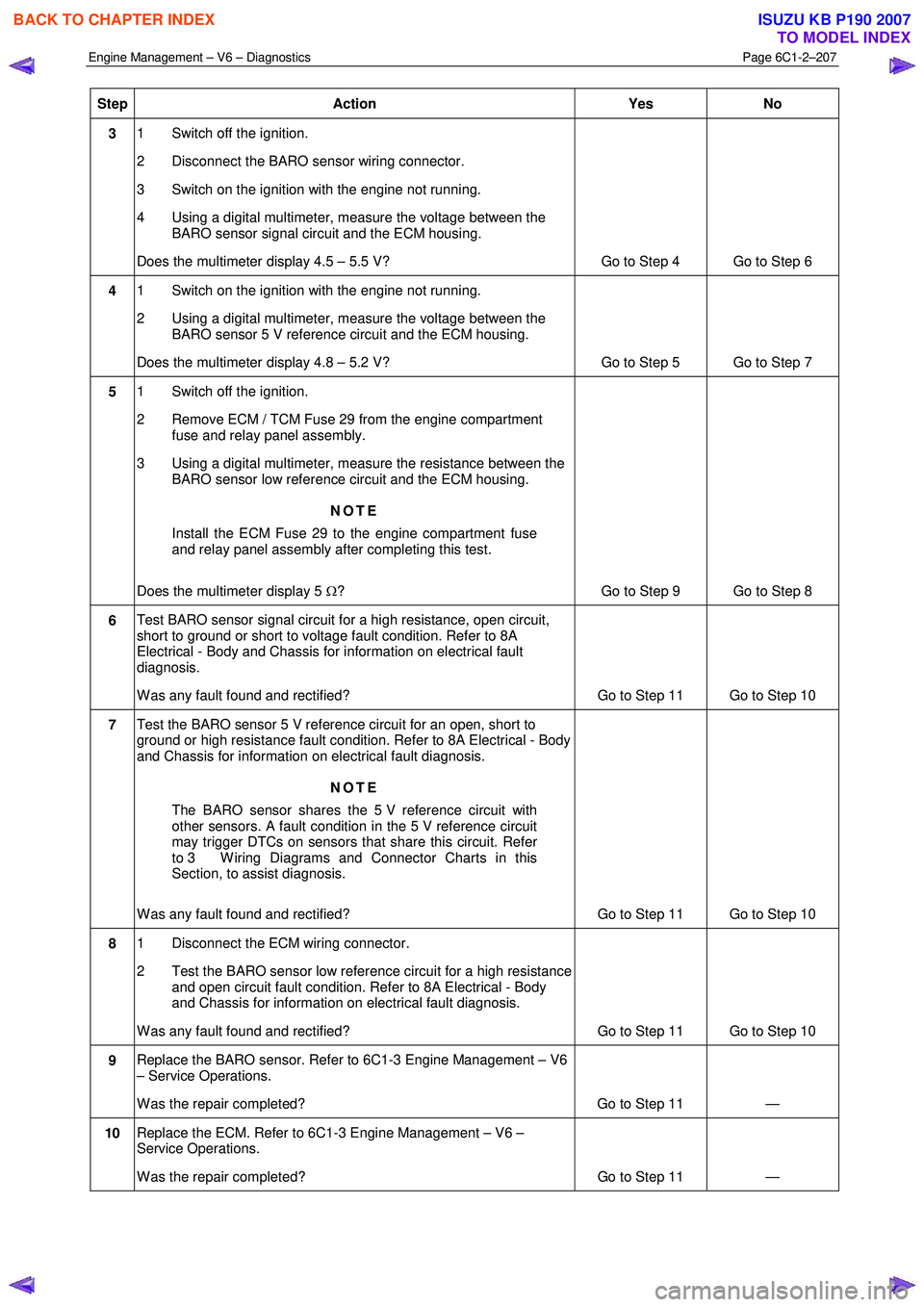
Engine Management – V6 – Diagnostics Page 6C1-2–207
Step Action Yes
No
3 1 Switch off the ignition.
2 Disconnect the BARO sensor wiring connector.
3 Switch on the ignition with the engine not running.
4 Using a digital multimeter, measure the voltage between the BARO sensor signal circuit and the ECM housing.
Does the multimeter display 4.5 – 5.5 V? Go to Step 4 Go to Step 6
4 1 Switch on the ignition with the engine not running.
2 Using a digital multimeter, measure the voltage between the BARO sensor 5 V reference circuit and the ECM housing.
Does the multimeter display 4.8 – 5.2 V? Go to Step 5 Go to Step 7
5 1 Switch off the ignition.
2 Remove ECM / TCM Fuse 29 from the engine compartment fuse and relay panel assembly.
3 Using a digital multimeter, measure the resistance between the BARO sensor low reference circuit and the ECM housing.
NOTE
Install the ECM Fuse 29 to the engine compartment fuse
and relay panel assembly after completing this test.
Does the multimeter display 5 Ω? Go to Step 9 Go to Step 8
6 Test BARO sensor signal circuit for a high resistance, open circuit,
short to ground or short to voltage fault condition. Refer to 8A
Electrical - Body and Chassis for information on electrical fault
diagnosis.
W as any fault found and rectified? Go to Step 11 Go to Step 10
7 Test the BARO sensor 5 V reference circuit for an open, short to
ground or high resistance fault condition. Refer to 8A Electrical - Body
and Chassis for information on electrical fault diagnosis.
NOTE
The BARO sensor shares the 5 V reference circuit with
other sensors. A fault condition in the 5 V reference circuit
may trigger DTCs on sensors that share this circuit. Refer
to 3 W iring Diagrams and Connector Charts in this
Section, to assist diagnosis.
W as any fault found and rectified? Go to Step 11 Go to Step 10
8 1 Disconnect the ECM wiring connector.
2 Test the BARO sensor low reference circuit for a high resistance and open circuit fault condition. Refer to 8A Electrical - Body
and Chassis for information on electrical fault diagnosis.
W as any fault found and rectified? Go to Step 11 Go to Step 10
9 Replace the BARO sensor. Refer to 6C1-3 Engine Management – V6
– Service Operations.
W as the repair completed? Go to Step 11 —
10 Replace the ECM. Refer to 6C1-3 Engine Management – V6 –
Service Operations.
W as the repair completed? Go to Step 11 —
BACK TO CHAPTER INDEX
TO MODEL INDEX
ISUZU KB P190 2007
Page 3489 of 6020
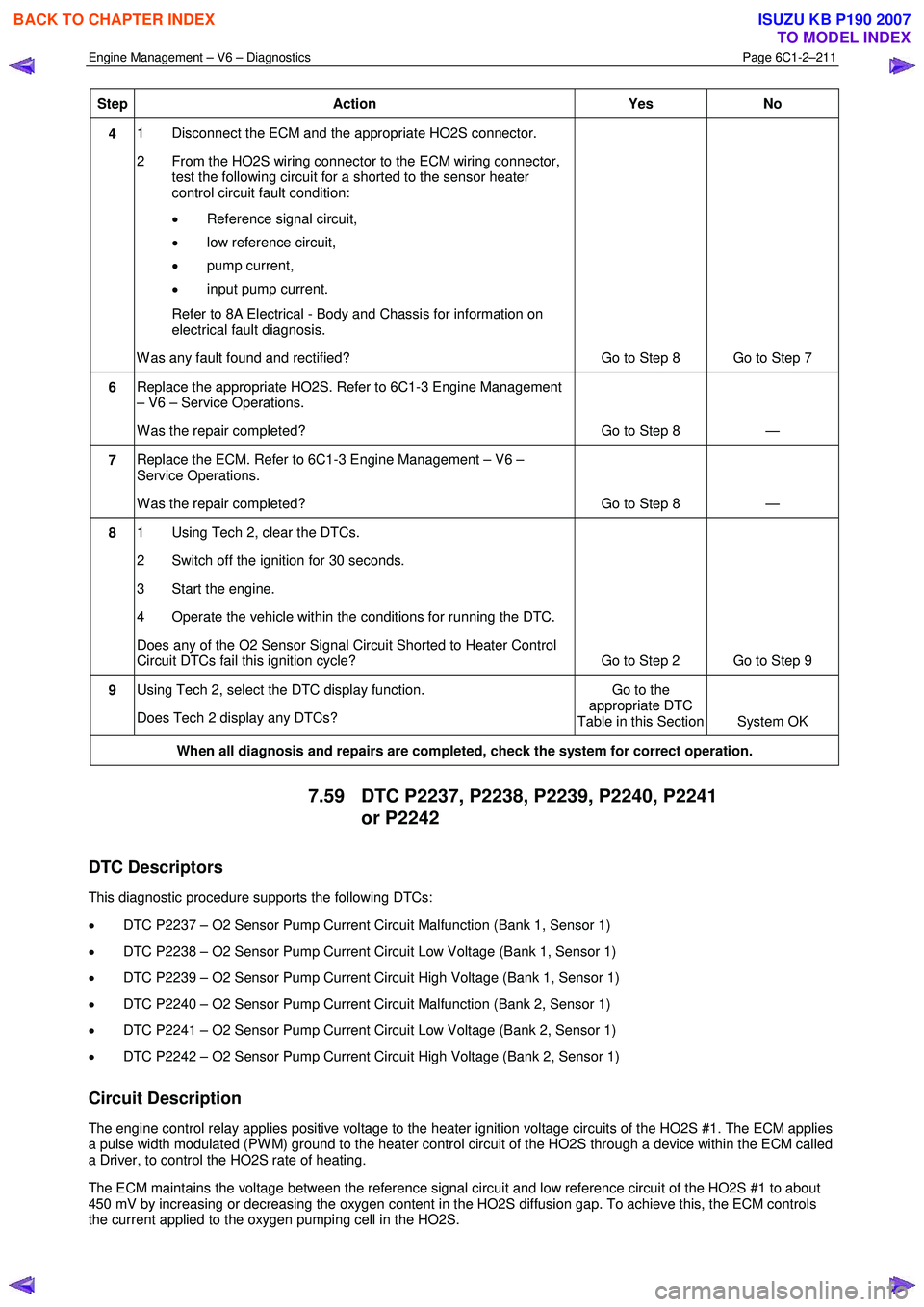
Engine Management – V6 – Diagnostics Page 6C1-2–211
Step Action Yes No
4 1 Disconnect the ECM and the appropriate HO2S connector.
2 From the HO2S wiring connector to the ECM wiring connector, test the following circuit for a shorted to the sensor heater
control circuit fault condition:
• Reference signal circuit,
• low reference circuit,
• pump current,
• input pump current.
Refer to 8A Electrical - Body and Chassis for information on electrical fault diagnosis.
W as any fault found and rectified? Go to Step 8 Go to Step 7
6 Replace the appropriate HO2S. Refer to 6C1-3 Engine Management
– V6 – Service Operations.
W as the repair completed? Go to Step 8 —
7 Replace the ECM. Refer to 6C1-3 Engine Management – V6 –
Service Operations.
W as the repair completed? Go to Step 8 —
8 1 Using Tech 2, clear the DTCs.
2 Switch off the ignition for 30 seconds.
3 Start the engine.
4 Operate the vehicle within the conditions for running the DTC.
Does any of the O2 Sensor Signal Circuit Shorted to Heater Control
Circuit DTCs fail this ignition cycle? Go to Step 2 Go to Step 9
9 Using Tech 2, select the DTC display function.
Does Tech 2 display any DTCs? Go to the
appropriate DTC
Table in this Section System OK
When all diagnosis and repairs are completed, check the system for correct operation.
7.59 DTC P2237, P2238, P2239, P2240, P2241
or P2242
DTC Descriptors
This diagnostic procedure supports the following DTCs:
• DTC P2237 – O2 Sensor Pump Current Circuit Malfunction (Bank 1, Sensor 1)
• DTC P2238 – O2 Sensor Pump Current Circuit Low Voltage (Bank 1, Sensor 1)
• DTC P2239 – O2 Sensor Pump Current Circuit High Voltage (Bank 1, Sensor 1)
• DTC P2240 – O2 Sensor Pump Current Circuit Malfunction (Bank 2, Sensor 1)
• DTC P2241 – O2 Sensor Pump Current Circuit Low Voltage (Bank 2, Sensor 1)
• DTC P2242 – O2 Sensor Pump Current Circuit High Voltage (Bank 2, Sensor 1)
Circuit Description
The engine control relay applies positive voltage to the heater ignition voltage circuits of the HO2S #1. The ECM applies
a pulse width modulated (PW M) ground to the heater control circuit of the HO2S through a device within the ECM called
a Driver, to control the HO2S rate of heating.
The ECM maintains the voltage between the reference signal circuit and low reference circuit of the HO2S #1 to about
450 mV by increasing or decreasing the oxygen content in the HO2S diffusion gap. To achieve this, the ECM controls
the current applied to the oxygen pumping cell in the HO2S.
BACK TO CHAPTER INDEX
TO MODEL INDEX
ISUZU KB P190 2007
Page 3493 of 6020

Engine Management – V6 – Diagnostics Page 6C1-2–215
10 1 Replace the appropriate HO2S. Refer to 6C1-3
Engine Management – V6 – Service Operations.
W as the repair completed? —
Go to Step 12 —
11 1 Replace the ECM. Refer to 6C1-3 Engine
Management – V6 – Service Operations.
W as the repair completed? —
Go to Step 12 —
12 1 Using Tech 2, clear the DTCs.
2 Switch off the ignition for 30 seconds.
3 Start the engine.
4 Operate the vehicle within the conditions for running the DTC.
Does any of the HO2S pumping current control circuit
DTCs fail this ignition cycle? —
Go to Step 2 Go to Step 13
12 Using Tech 2, select the DTC display function.
Does Tech 2 display any DTCs? —
Go to the
appropriate DTC Table in this Section System OK
When all diagnosis and repairs are completed, clear all DTCs and verify correct operation
7.60 DTC P2626, P2627, P2628, P2629, P2630
or P2631
DTC Descriptors
• DTC P2626 – O2 Sensor Pump Current Trim Circuit Malfunction (Bank 1, Sensor 1)
• DTC P2627 – O2 Sensor Pump Current Trim Circuit Low Voltage (Bank 1, Sensor 1)
• DTC P2628 – O2 Sensor Pump Current Trim Circuit High Voltage (Bank 1, Sensor 1)
• DTC P2629 – O2 Sensor Pump Current Trim Circuit Malfunction (Bank 2, Sensor 1)
• DTC P2630 – O2 Sensor Pump Current Trim Circuit Low Voltage (Bank 2, Sensor 1)
• DTC P2631 – O2 Sensor Pump Current Trim Circuit High Voltage (Bank 2, Sensor 1)
Circuit Description
The wide band heated oxygen sensor (HO2S) measures the amount of oxygen in the exhaust system and provides
more information than the switching style HO2S. The wide band sensor consists of an oxygen sensing cell, an oxygen
pumping cell, and a heater. The exhaust gas sample passes through a diffusion gap between the sensing cell and the
pumping cell. The engine control module (ECM) supplies a voltage to the HO2S and uses this voltage as a reference to
the amount of oxygen in the exhaust system.
An electronic circuit within the ECM controls the pump current through the oxygen pumping cell in order to maintain a
constant voltage in the oxygen sensing cell. The ECM monitors the voltage variation in the sensing cell and attempts to
keep the voltage constant by increasing or decreasing the amount of current flow, or oxygen ion flow, to the pumping
cell. By measuring the amount of current required to maintain the voltage in the sensing cell, the ECM can determine
the concentration of oxygen in the exhaust.
The HO2S voltage is displayed as a lambda value. A lambda value of 1 is equal to a stoichiometric air fuel ratio of
14.7:1. Under normal operating conditions, the lambda value will remain around 1. W hen the fuel system is lean, the
oxygen level will be high and the lambda signal will be high or more than 1. W hen the fuel system is rich, the oxygen
level will be low, and the lambda signal will be low or less than 1. The ECM uses this information to maintain the correct
air / fuel ratio.
Conditions for Running the DTC
• Before the ECM can report DTC P2626 or P2629 failed, DTCs P0101, P0121, P0122, P0123, P0221, P0222,
P0223, P0336, and P0338 must run and pass.
• The engine is operating.
BACK TO CHAPTER INDEX
TO MODEL INDEX
ISUZU KB P190 2007
Page 3496 of 6020
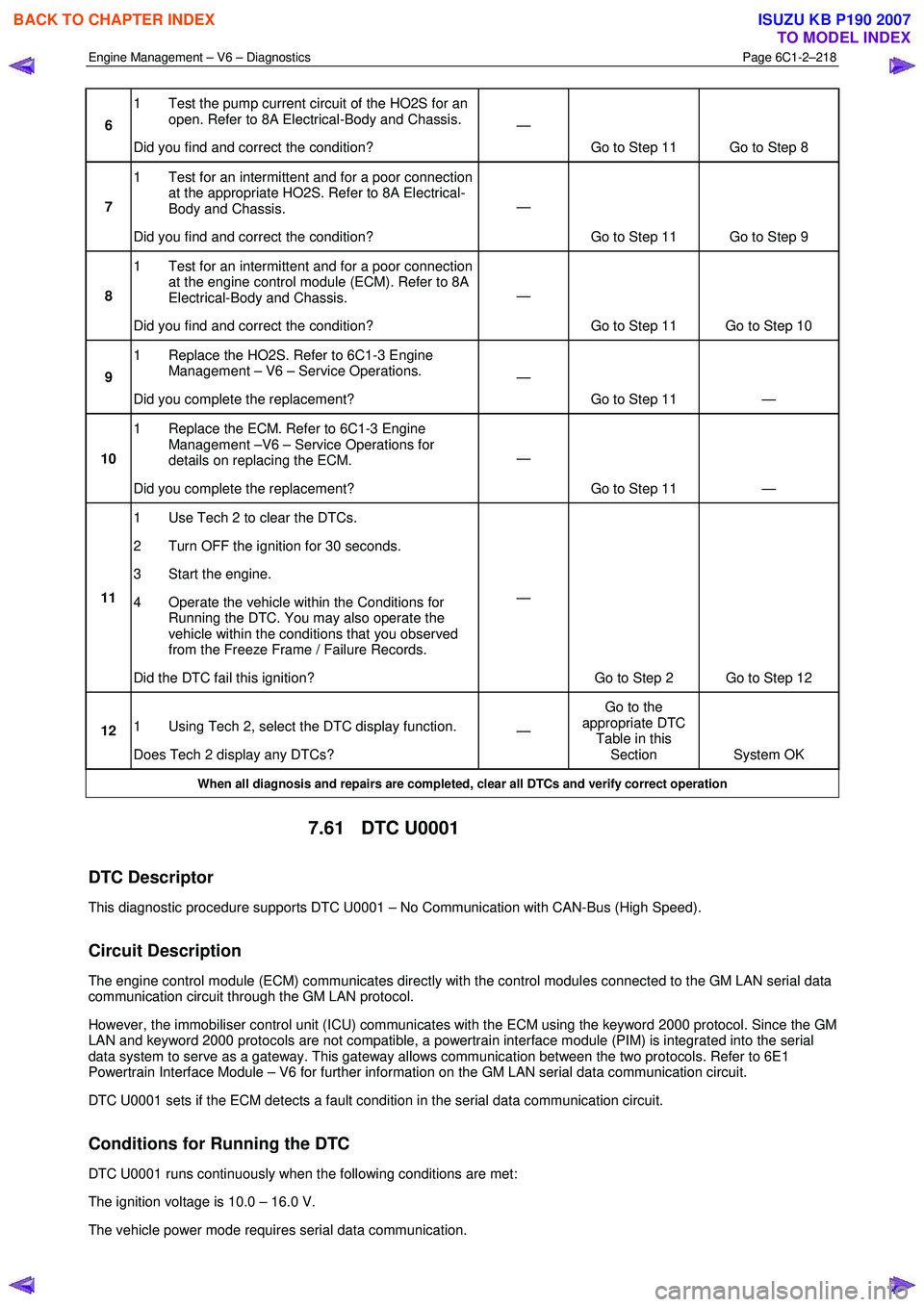
Engine Management – V6 – Diagnostics Page 6C1-2–218
6 1 Test the pump current circuit of the HO2S for an
open. Refer to 8A Electrical-Body and Chassis.
Did you find and correct the condition? —
Go to Step 11 Go to Step 8
7 1 Test for an intermittent and for a poor connection
at the appropriate HO2S. Refer to 8A Electrical-
Body and Chassis.
Did you find and correct the condition? —
Go to Step 11 Go to Step 9
8 1 Test for an intermittent and for a poor connection
at the engine control module (ECM). Refer to 8A
Electrical-Body and Chassis.
Did you find and correct the condition? —
Go to Step 11 Go to Step 10
9 1 Replace the HO2S. Refer to 6C1-3 Engine
Management – V6 – Service Operations.
Did you complete the replacement? —
Go to Step 11 —
10 1 Replace the ECM. Refer to 6C1-3 Engine
Management –V6 – Service Operations for
details on replacing the ECM.
Did you complete the replacement? —
Go to Step 11 —
11 1 Use Tech 2 to clear the DTCs.
2 Turn OFF the ignition for 30 seconds.
3 Start the engine.
4 Operate the vehicle within the Conditions for Running the DTC. You may also operate the
vehicle within the conditions that you observed
from the Freeze Frame / Failure Records.
Did the DTC fail this ignition? —
Go to Step 2 Go to Step 12
12 1 Using Tech 2, select the DTC display function.
Does Tech 2 display any DTCs? —
Go to the
appropriate DTC Table in this Section System OK
When all diagnosis and repairs are completed, clear all DTCs and verify correct operation
7.61 DTC U0001
DTC Descriptor
This diagnostic procedure supports DTC U0001 – No Communication with CAN-Bus (High Speed).
Circuit Description
The engine control module (ECM) communicates directly with the control modules connected to the GM LAN serial data
communication circuit through the GM LAN protocol.
However, the immobiliser control unit (ICU) communicates with the ECM using the keyword 2000 protocol. Since the GM
LAN and keyword 2000 protocols are not compatible, a powertrain interface module (PIM) is integrated into the serial
data system to serve as a gateway. This gateway allows communication between the two protocols. Refer to 6E1
Powertrain Interface Module – V6 for further information on the GM LAN serial data communication circuit.
DTC U0001 sets if the ECM detects a fault condition in the serial data communication circuit.
Conditions for Running the DTC
DTC U0001 runs continuously when the following conditions are met:
The ignition voltage is 10.0 – 16.0 V.
The vehicle power mode requires serial data communication.
BACK TO CHAPTER INDEX
TO MODEL INDEX
ISUZU KB P190 2007